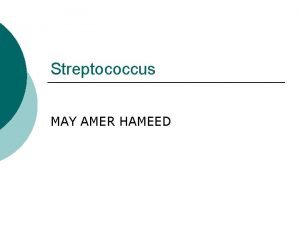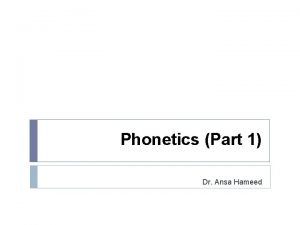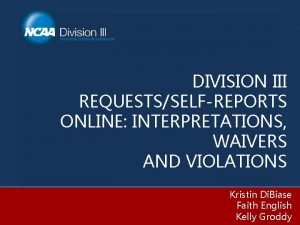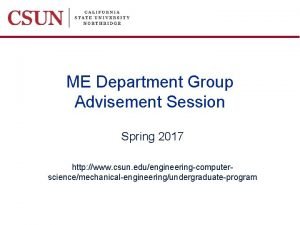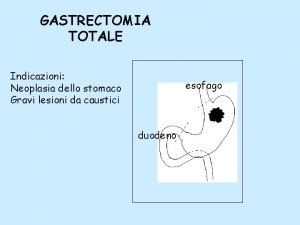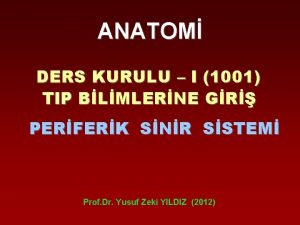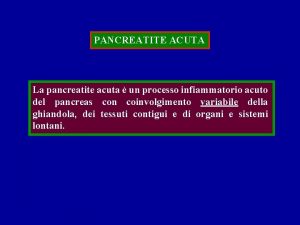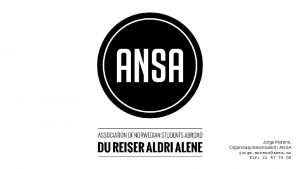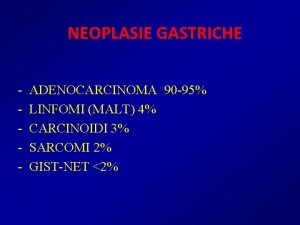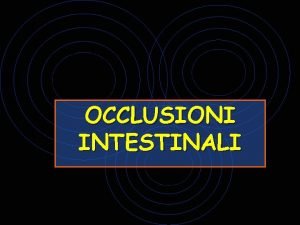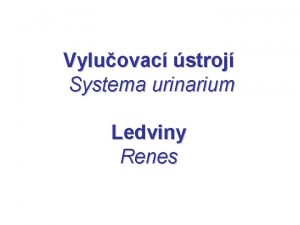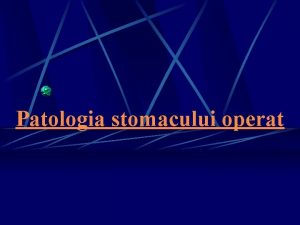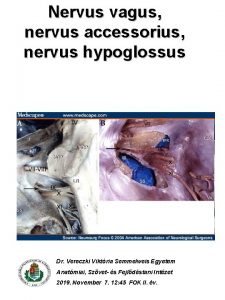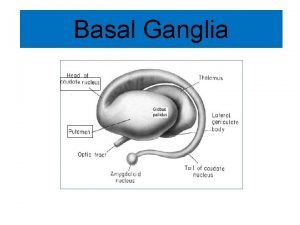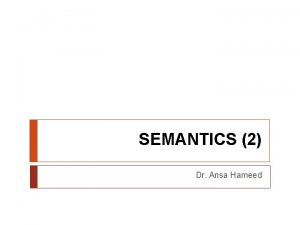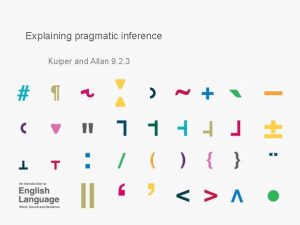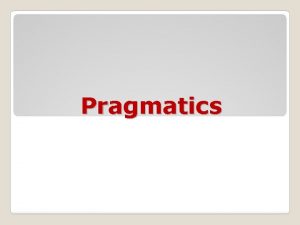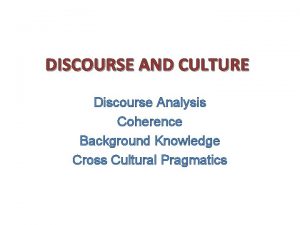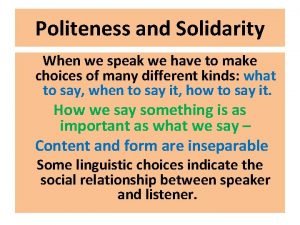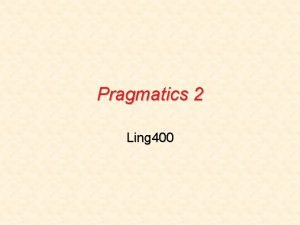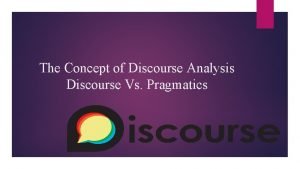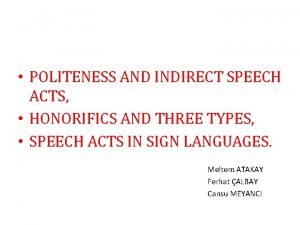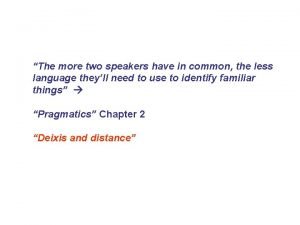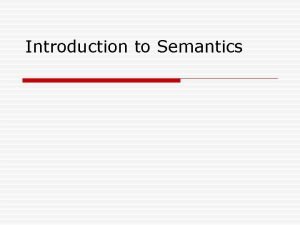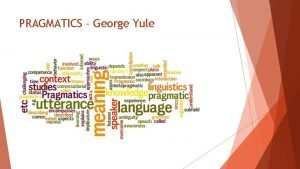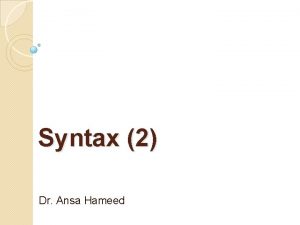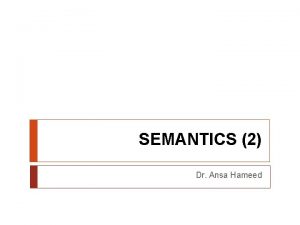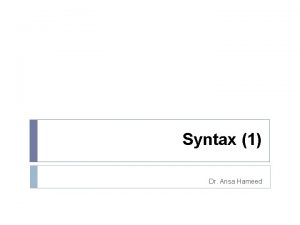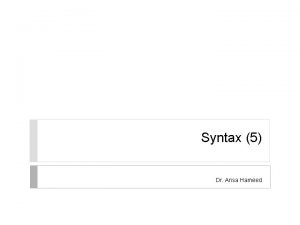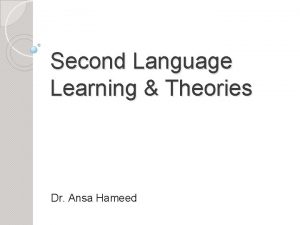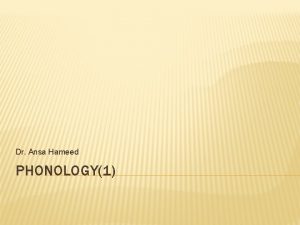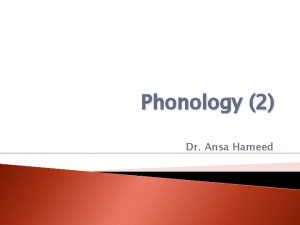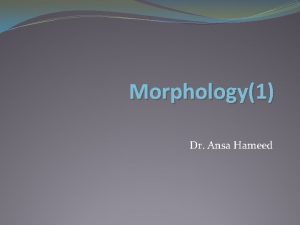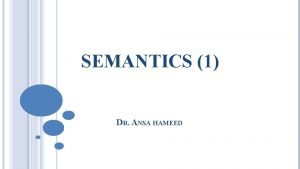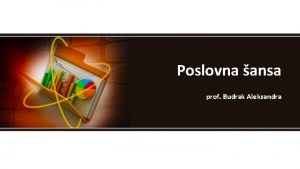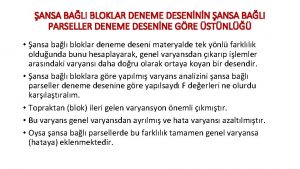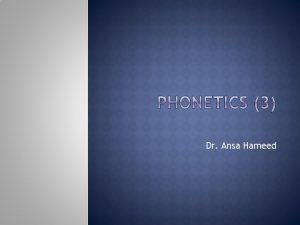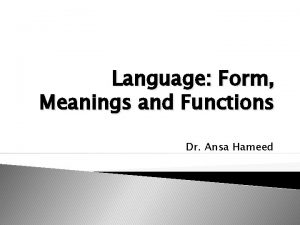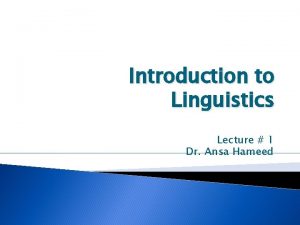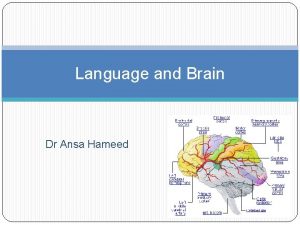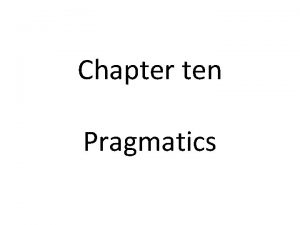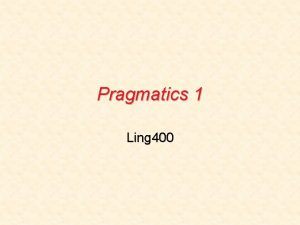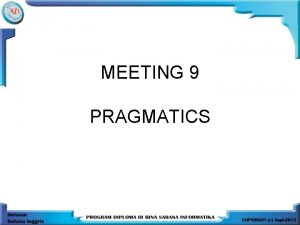Pragmatics 2 DR ANSA HAMEED Previously Pragmatics Importance



































- Slides: 35

Pragmatics (2) DR. ANSA HAMEED

Previously…. �Pragmatics? ? ? �Importance of Context? ? ? �Theories �Speech Act Theory

Today’s Lecture �Theories: 2. Relevance theory 3. Cooperation theory 4. Argumentation theory �Pragmatics & Discourse Analysis

2. Relevance Theory l Meaning is not merely a matter of decoding grammar. It is also a matter of knowing which of the many inferences that one can draw from an utterance are relevant. l Relevance is a matter deeply tied to context, point of view, and culture.

2. Relevance Theory � l. Example: Sentence 1. May have multiple meanings 2 -4. What does it mean? Try to fill in the blanks. � 1. Lung cancer death rates are clearly associated with an increase in smoking � a. increased smoking = people smoke more � b. increased smoking = more people smoke � c. increased smoking = __________ � d. the same people are smoking and dying � e. the people smoking and dying are not all ______ � f. the situation being talked about is real (because) � g. the situation being talked about is hypothetical ( )

3. Cooperation Theory COOPERATION THEORY The way in which people try to make conversations work.

3. Cooperation Theory: Maxims There are four subprinciples within this theory called maxims Quantity. (quantity of information) Quality (be truthful) Relevance/Relation (be relevance) Manner (be clear)

3. Cooperation Theory: Maxims � The Maxim of Quantity Be only as informative as required for current conversational purposes. � The Maxim of Quality Say only what you believe to be true and adequately supported. � The Maxim of Relation Be relevant. � The Maxim of Manner Be clear: be brief and orderly and avoid obscurity and ambiguity.

3. Cooperation Theory: Maxims � 1. Maxim of quantity �Make your contribution as informative as required for the current purposes of the exchange. �Do not make your contribution more informative than is required.

3. Cooperation Theory: Maxims � 2. Maxim of quality �Try to make your contribution one that is true. �Do not say what you believe to be false. �Do not say that for which you lack adequate evidence.

3. Cooperation Theory: Maxims � 3. Maxim of Relevance Be relevant Example: � A Well, how do I look? � B Your shoes are nice.

3. Cooperation Theory: Maxims � 4. Maxim of Manner Avoid obscurity of expression Avoid ambiguity Be brief Be orderly � Example: � A Does your dog bite? � B No. � A [Bends down to stroke it and gets bitten] Ow! You said your dog doesn’t bite. � B That isn’t my dog.

3. Cooperation Theory: Maxims � Infringing a maxim: Fail to observe a maxim because of their imperfect linguistic performance (a child or a foreign learner): nervousness; drunkenness; excitement; cognitive impairment; incapability of speaking clearly. Example: Bush said Gates would not routinely attend Cabinet meetings but would take part in sessions where intelligence was necessary for making decision.

When not observing Maxims…. . Implicatures By observing the cooperative principle, interlocutors are able to work out what is meant from what is said. l. Utterances do not always carry their literal meaning. l. Non-literal meaning must be inferred from context and the cooperative principle. l. Non-literal interpretations are referred to as implicatures. l. Implicature is a special type of inference in which the hearer makes the assumption that the speaker is NOT breaking one of the conversational maxims of quantity, quality, relation, and manner.

When not observing Maxims: Face Theory �In order to explain why in many cases people express themselves implicitly and indirectly by flouting the four maxims of the cooperative principle, Brown and Levinson (1978) advanced the Face Theory. Leech (1983: 132) developed the face theory further and formulated the politeness principle.

When not observing Maxims: Face Theory �According to this theory, everybody has face wants, i. e. the expectation concerning their public selfimage. In order to maintain harmonious interpersonal relationships and ensure successful social interaction, we should be aware of the two aspects of another person's face, i. e. the positive face and the negative face.

3. Cooperation Theory �Limitations of the Cooperative Principles: � Different cultures, countries, and communities have their own ways of observing and expressing maxims for particular situations. � There is often an overlap between the four maxims. It can be difficult to say which one is operating and it would be more precise to say that there are two or more operating at once.

4. Argumentation Theory ARGUMENTATION THEORY � Interdisciplinary study of how humans do reach conclusions through logical reasoning � Argumentation includes debate and negotiation which are concerned with reaching mutually acceptable conclusions.

4. Argumentation Theory �Typically an argument has an internal structure, comprising the following �a set of assumptions or premises �a method of reasoning or deduction and �a conclusion or point. �An argument must have at least two premises and one conclusion

� Pragmatic Analysis

Pragmatic Analysis PRAGMATIC ANALISYS 1. Related to the situation 2. Related to the context 3. Related to the people 4. Related to the information

Pragmatic Analysis 1 RELATED TO THE SITUATION We adapt our conversation to different situations, depending on the place and the time where the speech occurs.

Pragmatic Analysis 2 RELATED TO THE PEOPLE Depending on who you are with and the relation between those people, the conversation will have different meaning. Example: Ironic utterances with friends and with unknown people.

Pragmatic Analysis 3 RELATED TO THE CONTEXT Within the people, there are clues in the context that allow us to notice that irony (to say the opposite of what it actually means) Example: Facial expressions.

Pragmatic Analysis 4 RELATED TO THE INFORMATION Presuppositions about the world-knowledge of hearers; i. e meanings that can be deducted by listeners because they already know about that information.

�Pragmatics & Discourse Analysis

Pragmatics & Discourse Analysis �Pragmatics is the study of language usage from a functional perspective and is concerned with the principles that account for how meaning is communicated by the speaker (writer) and interpreted by the listener (reader) in a certain context. �Like pragmatics, text analysis is also concerned with language used in particular contexts. It is the linguistic analysis of naturally occurring connected spoken or written texts. �In other words, it is the study of linguistic units larger than sentences or clauses.

Pragmatics & Discourse Analysis �Discourse Analysis can focus all theories related to Pragmatics to analyse discourses and at the same time it focuses certain features of text as well like: �Cohesion �Reference �Substitution & Ellipsis �Conjunction �Theme & Rheme

Pragmatics & Discourse Analysis �Cohesion: �A text is not a collection of lexical items and/or sentences in random. Instead, it must be semantically unified. In other words, it must have texture, i. e. the property that distinguishes a text from a non-text. The unity of a text can be achieved by a number of semantic and lexicogrammatical means, among which the most important is cohesion .

Pragmatics & Discourse Analysis �Reference refers to the semantic relation in which a word or words are used to enable the addressee to identify someone or something. The word or words used for reference are called the reference item. The person(s) or thing(s) identified by the reference item are called the referent. Reference is a specific nature of information that is signaled for retrieval. The information to be retrieved is the referential meaning. �John has moved to a new house. He had it built last year.

Pragmatics & Discourse Analysis �Substitution & Ellipsis �Substitution refers to the replacement of one item by another and ellipsis the omission of an item. Unlike reference, which is a relation between meanings, substitution and ellipsis are a relation between linguistic items. Substitution and ellipsis are two closely related processes. �A: I ate two eggs and a cup of milk for my breakfast. �B: I ate the same.

Pragmatics & Discourse Analysis �Conjunction in grammar refers to a word or expression like and, but, or that connects words, phrases, clauses and/or sentences. As one of the major grammatical cohesive ties, however, this term is used to focus on the inter-clausal and intersentential levels. In other words, we concentrate on how the conjunctive expressions contribute to the cohesion of a text.

Pragmatics & Discourse Analysis � Theme and Rheme � Theme can be defined as the element which serves as the point of departure of the message conveyed by the clause. It is the ground from which the clause is taking off. In English, this element always takes the first position of a clause. The remaining part of the message, the part in which the Theme is developed, is called the Rheme. � Example: � My parents gave me � Theme � a new bicycle Rheme

Recap �Pragmatics �Theories �Pragmatic analysis �Pragmatics and Discourse Analysis �Pragmatics as an important factor when it comes to understanding the language in a deeply way as words do not have meaning by themselves.

References Searle, J. R. ; Kiefer, F. & Bierwisch, M. (1980). Speech act theory and Pragmatics. Dordnecht; Holland. � Baena, E. ; Lacorte, M. (2002). Para entender la Pragmática. Ed. Gredos. � Yule, G. (1996). Pragmatics. Oxford: University Press. � http: //www. helsinki. fi/~pietarin/publications/Relevance%20 theory-Pietarinen. pdf � Falk, Julia. Linguistics and Language. 1978. � Hocket, F. C. A Course in Modern Linguistics. New Delhi: Oxford. 1958 �
 Bacterial capsul
Bacterial capsul Hakim abdul hameed
Hakim abdul hameed Chino masjid
Chino masjid Obstruent consonants
Obstruent consonants Mirza definition
Mirza definition What thailand was previously known as
What thailand was previously known as Previously approved waivers ncaa
Previously approved waivers ncaa Csun ece 240
Csun ece 240 Domain bacteria facts
Domain bacteria facts Ansa alla roux
Ansa alla roux Plexus cervicalis en önemli siniri
Plexus cervicalis en önemli siniri Ansa sentinella pancreatite
Ansa sentinella pancreatite Bilroth ii
Bilroth ii Fiziologia rinichiului
Fiziologia rinichiului Ansa forsikring
Ansa forsikring Borrmann classificazione
Borrmann classificazione Ileo meccanico rx
Ileo meccanico rx Ansa umbilicalis
Ansa umbilicalis Ren dystopicus
Ren dystopicus Ansa aferenta
Ansa aferenta Nervus hypoglossus
Nervus hypoglossus Internal medullary lamina
Internal medullary lamina Hyponymy
Hyponymy Irina jusupova
Irina jusupova Strap muscles of neck
Strap muscles of neck Relevance theory in pragmatics
Relevance theory in pragmatics What are pragmatics
What are pragmatics Background knowledge context
Background knowledge context Solidarity definition
Solidarity definition Implicature scalari
Implicature scalari Relationship between pragmatics and discourse analysis
Relationship between pragmatics and discourse analysis Direct indirect speech act
Direct indirect speech act Deixis in pragmatics
Deixis in pragmatics Semantic triangle example
Semantic triangle example Deixis and distance
Deixis and distance Locutionary illocutionary and perlocutionary acts examples
Locutionary illocutionary and perlocutionary acts examples
